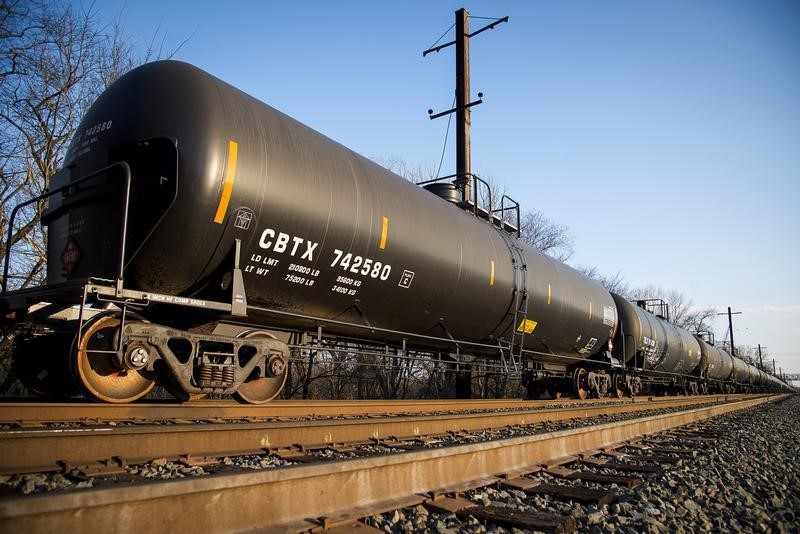By Nia Williams and Jarrett Renshaw
CALGARY, Alberta/NEW YORK (Reuters) - Canadian rail companies are slashing rates for shipping crude in their first serious effort to revive an industry rocked by the rout in global oil prices, according to shippers and terminal operators who are seeing discounts of as much as 25 percent.
The move highlights how railroads are struggling to compete with pipelines for a share of shrinking crude shipments across North America, particularly in Canada, where a long hoped-for boom in oil sands traffic has fizzled with the oil bust.
Canadian National Railway and Canadian Pacific Railway, which together account for the vast majority of crude-by-rail cargoes shipped across the country, are dropping prices, four people familiar with the cuts told Reuters. The size of the cuts varied among sources, leading one source to suggest that railroads may be working with individual shippers to give some bigger discounts than others.
Canadian National said it does not publicly discuss its freight rates. Canadian Pacific said it does not comment on individual customer relationships.
Canadian Pacific has offered discounts of around 15-25 percent, but in exchange wants shippers to commit to firm volumes, for example one 70,000 barrel unit train, made up entirely of oil tanks cars, per month for three months, said one source with a Calgary-based midstream company.
Another shipper said his company had been offered a single digit discount giving them a "small amount of relief".
Shipments from Canada to the United States have plunged by more than a third this year to 112,000 barrels per day in July, according to the latest U.S. data, undermining industry forecasts made before the oil price crash that total Canadian crude by rail volumes could hit 700,000 bpd by end-2016.
"They have cut their rates to help attract volumes. All the railways are doing it," said John Zahary, chief executive of Altex Energy Ltd, which operates five rail loading terminals in Canada and whose customers are shippers. "It's certainly helpful in getting volumes, but it's still tough out there."
Zahary's company has also taken a haircut, trimming costs where possible, and loads about 100 cars a day at Altex terminals, less than full capacity, he said.
A senior executive at another Canadian rail terminal operator said over the last four months freight rates had come off around 10 to 20 percent and as a result rail volumes had picked up slightly since August.
Canadian oil sands producers that ship their crude by rail include Cenovus Energy, which also owns a unit train loading terminal in Alberta, and Suncor Energy. Cenovus declined to comment on its commercial agreements, while Suncor did not immediately respond to a request for comment.
Rates vary according to whether the crude is being shipped on dedicated unit trains or alongside other cargoes, and whether the barrels are under contract or one-time spot shipments.
The rate for committed manifest barrels to the U.S. Gulf or East Coast now costs around $13-$15 a barrel, down from $15-$17 earlier this year, according to one of the people.
Even so, crude by rail economics remain challenging, with the narrow spread between international Brent and U.S. benchmark inland crude making it difficult for Canadian barrels to compete with overseas imports into U.S. markets.
Canadian differentials, another factor in determining the viability of crude by rail, are also relatively narrow. Heavy crude was last trading at around $15 per barrel below U.S. benchmark crude, having ranged between $9 and $20 a barrel below since June.
IS IT WORKING?
At least one Canadian oil producer that has not previously loaded crude onto trains is considering adopting rail transport because of lower rates, said a source at the company who declined to be named.
But the economics of crude by rail are still "considerably underwater," according to one source, and it's too early to tell whether the rate cuts are enough to stimulate more traffic.
The latest data from the U.S. Energy Information Administration hints the tide might be starting to turn, with July volumes up 72 percent from June.
Those numbers do not include volumes shipped within Canada which Taylor Robinson, president of crude by rail advisers PLG Consulting, said would take the total to 175,000 bpd of crude. Just a few years ago, the company estimated Western Canadian crude loadings would be up to 400,000 barrels per day by 2015.
Narrow Canadian crude differentials earlier this year and new pipelines out of Western Canada had contributed to low volumes but if production ramps up as forecast, Robinson said, in spite of low global oil prices, crude by rail could swing back into favour.
"Production should rise, and they are going to run out of pipeline capacity, so there is going to be an increase in rail traffic," Taylor said.
